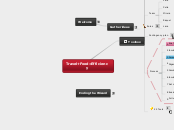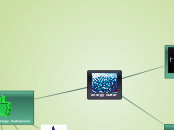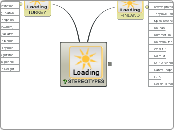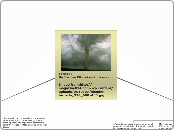Welcome
Welcome, Guest
This Mindomo Smart Map creates a toolbox map to support a brainstorming session. The Smart Map wizard helps you to define the session. You then save the map as a normal Mindomo map, and use it to support the brainstorming session and follow-up. You can refer back to this Toolbox area for reference information, process guidance and ideas if you get stuck.
This floating topic can be deleted after you save the map as a normal map.
Gather ideas
Our project will help those people, specially business people who lose their time in the transfers they need to do.
Rules
- Do not prioritise or evaluate ideas when gathering them. Do not suppress ideas because they are too strange or obscure. Censure anyone who does this directly or indirectly.
- Do not attach ideas to people. Ideas become owned by the group when they are submitted.
- Aim for sheer quantity, not quality.
- Keep on track and keep the objective and the scenario in mind all the time. Limit off-topic discussions that will never rejoin the main thread.
Ending the Wizard
You can delete this topic from your saved Mindomo map.
Ending the Wizard
Once you have completed the setup wizard, you can save this map as a normal Mindomo map and use it to:
- Manage your brainstorm session, sharing the information and process with participants
- Capture ideas into the map, then rearrange and evaluate them
- Refer to the 20 creativity tools if you get stuck during your brainstorm session
This floating topic can be deleted after you save the map as a normal map.
Good luck with your brainstorm session!
Travel+Food=Efficiency
Name your brainstorming session
Type in the name or subject of your brainstorming session and press Enter.
Toolbox
22 Tools
To improve and gather ideas we used mindomo and canva.
Invert assumptions
Identify the assumptions in the scenario, then reverse them to see how it changes the scenario and ideas.
What would a famous person do?
Select a famous person with marked character traits. What would they do in this situation?
Inject random words
Inject random words from a newspaper into the scenario description. to see how this changes the ideas around it
Try the Medici effect
How could this problem be solved in a completely different environment?
Is it like anything else that has been solved in a different way?
Use constructive language
Instead of asking "How can we solve X?", ask "How many ways can we achieve Y?" Assume that there are multiple solutions and you just need to find a few. This small difference in language can make a big difference to thinking.
Wear Six Thinking Hats
Think from six distinct perspectives with Edward de Bono's Six Thinking Hats:
- White Hat: focus on facts
- Yellow Hat: be optimistic
- Black Hat: be judgmental and look for problems
- Red Hat: react emotionally, have hunches and intuitions
- Green Hat: be creative and look for possibilities
- Blue Hat: thinking about thinking
Think in reverse
If you are trying to solve a problem that has symptoms, think in reverse. What could you to to make things worse, not better? What would have the biggest effect? What is the worst outcome you could achieve?
Can you reverse that thinking again to find a solution?
Justify ideas
Ask a participant to justify one of their ideas. The discussion may spark some alternatives.
Examine forces at work
What are the forces acting on this situation? Can you change the balance of forces?
Analyse the gap
Focus on the gap between where you are now and where you want to be. How can that gap be changed? What would make it even bigger?
Work in pairs
Challenge and push each other in pairs rather than in a group. You might get more insightful and honest inputs.
SWOT analysis
List the strengths, weaknesses, opportunities and threats of the scenario to highlight any unexplored aspects
Exaggerate
Scale the problem or opportunity up or down by 1000. How would you deal with it if it were 1000 times bigger or 1000 time smaller?
Do the opposite
What would happen if you did the exact opposite of the sensible answer?
Take a break
Take a break from the process and let ideas incubate. You may get more energy from the group tomorrow morning, or after doing something completely different.
Change perspectives
How does the scenario look to other people? Think and act like competitors, customers, enemies, friends, experts, uninformed people, different ages, different genders, people at different levels in the organisation, people in different industries. Decide whether the situation depends on your point of view.
Word associations
Pick some key words from the ideas and find associated words. Do they lead to anything different?
Break rules
Define the rules that govern a process or situation. then try to break them or get around them
Work anonymously
Gather ideas anonymously, and vote on them
Challenge the scenario
Review the scenario again and challenge it.
- What assumptions have been made?
- Might it be incomplete or incorrectly described?
- It is really the situation, or is there something else behind it?
- Why and how has this situation arisen?
Watch for criteria drift
Make sure that you are consistent in your criteria when evaluating ideas. It is common for an idea to be rejected for a reason that has not been applied to all ideas. Do not reject an idea for a specific reason unless that criteria has been used from the beginning of your evaluation. If you realise that your criteria are incomplete, you may need to restart your evaluation.
Watch for groupthink
Groupthink can lead to loss of potentially valuable input, and poor joint decisions. It occurs when:
- A strong person influences others with their opinions or behaviour
- People stay silent when they disagree
- The group believes it must be right because of who it is
- There is strong external pressure to go in a particular direction
- There is little diversity of knowledge and backgrounds in the group
- Consensus is based on lack of objections rather than on positive support
- Some favourite ideas get attention without much consideration of alternatives
Make sure your group is exploring possibilities without judgement, and that all inputs are treated equally. Use some of the other tools to break down groupthink.
Process
The process is the list of steps for running the session. You should
- Review it before the session
- Customise it if necessary to remove any steps that you do not want to include
- Refer back to this during the session.
Follow-up
We are open top new ideas to improve our app.
We would like to get profit of this idea not only in airports but also in the city.
Evaluate ideas
As we don't like to waste time in airports while transferring, we created this app which helps people to know what to do and where to go.
Set minimum criteria
It is specially for business people who travel a lot and don't want to waste their time.
Criteria or requirements
What are your minimum criteria for moving forwards with a new idea? You will need some sort of baseline against which to filter ideas. Ideas should be filtered against the same criteria. Developing and agreeing the criteria can help to refine ideas. If you already know some of the criteria, set them out in advance, otherwise you may lose sight of them in a brainstorming session.
Criterion
Add a criterion
Add a criterion or requirement against which you will filter and score ideas. Think about:
- Performance, must-have or must-do factors
- Investment, costs, resources, timescales or other constraining factors
- Feasibility
- Alignment with strategy
- Acceptable risk levels
Incubate ideas
To do so we will create an app and a webpage so everything is in the net.
Combine and build on ideas
- You will be able to order food before taking off so when you arrive to the airport to do the transfers you have something to eat there and you don't waste your time looking for a good restaurant.
- You will also be able to find something to do related with your interests in the airport.
Organise and group ideas
- Our idea is an app for making transfers easier.
- It is specially for business people who travel frequently.
- Ordering food before going to the restaurant.
Personal brainstorming
- For business people who travel a lot for work
- People who like to travel
- Families
- Hostess who spend lots of time in airport for work
- Influencers who recommend people what to use
Services
Choosing options
Activities
-spa
-massage
-nails
Shopping
-High end shops
-Technology
-Souvenirs
Food
-healthy food
-vegan food
-american food
-gluten free
Incubate the problem
Imagine you are a business man and you travel every week in which you have to wait for three hours in an airport because of a transfer. With our mobile app, you won't have any problem for the reason that you will know where to go and what to do.
Brief the team
- Our objective is to make the transfers of all the passengers easier and more comfortable.
- We have two hours per day in a whole week to finish it.
- We are working on this project in the university.
- We are organizing each task for everyone so all of us is working on something different.
Contingency plan
The contingency plan is the route that you will take if nothing better can be found.
Contingency plan
Having a contingency plan guarantees action. If the brainstorming process collapses or fails to produce anything, the contingency plan states what you will do instead. The contingency plan may be an unattractive route, and can include doing nothing at all. It helps to avoid leaving brainstorming sessions in an inconclusive state, and could help to motivate participants to come up with something better.
Add an action
Add an action to the contingency plan. Identify the results that the contingency plan will lead to.
Team
The team
Who will take part in this session?
Lara
Raquel
Mireia
Celia
Laia
Add a team member and role
Add a team member for this brainstorming session.
- You may need someone to write up the ideas, but whoever does this will not be able to fully participate. They should not be filtering and interpreting input, nor trying to think of their own ideas while capturing other input.
- You will need someone to lead the group, who may find that this limits their participation. This should not be someone who might intimidate others through their seniority or expertise.
- A group size of 5 to 7 is ideal. Bigger groups do not always work better.
- A mix of backgrounds and knowledge will work better than a group of people who all think along similar lines.
- People who are willing to question assumptions and the status quo are just as valuable as people with subject expertise.
Scenario
The design brief, problem or opportunity that this session is addressing
Scenario
The scenario is your briefing for participants. It could be a design brief, a problem or an opportunity. You should pursue only one scenario in a brainstorming session. Do not try to address multiple questions.
Description
Add a line describing the scenario
Add a line describing an aspect of the scenario. Some of your participants may already understand it, and some may not. Both positions are useful. Explain the special features of the situation that need inventive ideas. Challenge your participants.
Time constraints
Time constraints
You should set some time constraints, but make sure that people do get time to think. Two short sessions over a couple of days may be much more productive than one long session.
Time allowed
Time allowance
How many sessions and how much time for sessions?
Objective
Create a project that reflects our interests and passions. To provide a solution for problems that we have experienced, to improve the efficiency and productivity of the company and its objective. To sum up, give a useful service and customers convenience.
Create a business that reflects our interests and passions, providing a solution to a problem that we have experienced. Provide an innovative and useful service to improve the efficientcy and productivity.
What is your objective?
State a specific objective for your session. Make sure your objective includes follow-through and actions. Avoid using brainstorming to make a decision, to gather opinions, or to simply come up with input with no plan to change anything. Common objectives include:
- Creating something new
- Solving a problem
- Maximising an opportunity
Overview
The foundations of a successful brainstorming session are:
-> A clear objective
-> A well-defined problem or opportunity
-> A group that understands the brainstorming process
-> Follow-up and action
The advantage of making these visible in a map is that everyone can see the plan and rules, and can refer back here to resolve blockages or loss of direction.
Objective:
give a useful service and customers convenience









